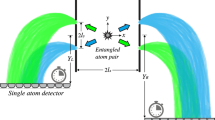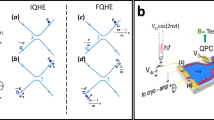Abstract
Very much like the ubiquitous quantum interference of a single particle with itself1, quantum interference of two independent, but indistinguishable, particles is also possible. For a single particle, the interference is between the amplitudes of the particle’s wavefunctions, whereas the interference between two particles is a direct result of quantum exchange statistics. Such interference is observed only in the joint probability of finding the particles in two separated detectors, after they were injected from two spatially separated and independent sources. Experimental realizations of two-particle interferometers have been proposed2,3; in these proposals it was shown that such correlations are a direct signature of quantum entanglement4 between the spatial degrees of freedom of the two particles (‘orbital entanglement’), even though they do not interact with each other. In optics, experiments using indistinguishable pairs of photons encountered difficulties in generating pairs of independent photons and synchronizing their arrival times; thus they have concentrated on detecting bunching of photons (bosons) by coincidence measurements5,6. Similar experiments with electrons are rather scarce. Cross-correlation measurements between partitioned currents, emanating from one source7,8,9,10, yielded similar information to that obtained from auto-correlation (shot noise) measurements11,12. The proposal of ref. 3 is an electronic analogue to the historical Hanbury Brown and Twiss experiment with classical light13,14. It is based on the electronic Mach–Zehnder interferometer15 that uses edge channels in the quantum Hall effect regime16. Here we implement such an interferometer. We partitioned two independent and mutually incoherent electron beams into two trajectories, so that the combined four trajectories enclosed an Aharonov–Bohm flux. Although individual currents and their fluctuations (shot noise measured by auto-correlation) were found to be independent of the Aharonov–Bohm flux, the cross-correlation between current fluctuations at two opposite points across the device exhibited strong Aharonov–Bohm oscillations, suggesting orbital entanglement between the two electron beams.
This is a preview of subscription content, access via your institution
Access options
Subscribe to this journal
Receive 51 print issues and online access
$199.00 per year
only $3.90 per issue
Buy this article
- Purchase on Springer Link
- Instant access to full article PDF
Prices may be subject to local taxes which are calculated during checkout




Similar content being viewed by others
References
Feynman, R. P., Leighton, R. B. & Sands, M. The Feynman Lectures on Physics Vol. III, Quantum Mechanics (Addison-Wesley, New York, 1965)
Yurke, B. & Stoler, D. Bell’s-inequality experiments using independent-particle sources. Phys. Rev. A 46, 2229–2234 (1992)
Samuelsson, P., Sukhorukov, E. V. & Buttiker, M. Two-particle Aharonov-Bohm effect and entanglement in the electronic Hanbury Brown-Twiss setup. Phys. Rev. Lett. 92, 026805 (2004)
Einstein, A., Podolsky, B. & Rosen, N. Can quantum-mechanical description of physical reality be considered complete? Phys. Rev. 47, 777–780 (1935)
Mandel, L. Quantum effects in one-photon and two-photon interference. Rev. Mod. Phys. 71, S274–S283 (1999)
Kltenbaek, R. et al. Experimental interference of independent photons. Phys. Rev. Lett. 96, 240502 (2006)
Kumar, A. et al. Experimental test of the quantum shot noise reduction theory. Phys. Rev. Lett. 76, 2778–2781 (1996)
Oliver, W. D., Kim, J., Liu, R. C. & Yamamoto, Y. Hanbury Brown and Twiss-type experiment with electrons. Science 284, 299–301 (1999)
Henny, M. et al. The fermionic Hanbury Brown and Twiss experiment. Science 284, 296–298 (1999)
Klessel, H., Renz, A. & Hasselbach, F. Observation of Hanbury Brown-Twiss anticorrelations for free electrons. Nature 418, 392–394 (2002)
Reznikov, M., Heiblum, M., Shtrikman, H. & Ma’halu, D. Temporal correlation of electrons: Suppression of shot noise in a ballistic quantum point contact. Phys. Rev. Lett. 75, 3340–3343 (1995)
Gavish, U., Levinson, Y. & Imry, Y. Shot-noise in transport and beam experiments. Phys. Rev. Lett. 87, 216807 (2001)
Hanbury Brown, R. & Twiss, R. Q. A new type of interferometer for use in radio astronomy. Phil. Mag. 45, 663–682 (1954)
Hanbury Brown, R. & Twiss, R. Q. Correlation between photons in two coherent beams of light. Nature 177, 27–29 (1956)
Ji, Y. et al. An electronic Mach-Zehnder interferometer. Nature 422, 415–418 (2003)
Halperin, B. I. Quantized Hall conductance, current-carrying edge states, and the existence of extended states in a two-dimensional disordered potential. Phys. Rev. B 25, 2185–2190 (1982)
Lesovik, B. G. Excess quantum shot noise in 2D ballistic point contacts. JETP Lett. 49, 592–594 (1989)
Born, M. & Wolf, E. Principles of Optics 7th edn 348–352 (Cambridge Univ. Press, Cambridge, UK, 1999)
Neder, I. et al. Unexpected behavior in a two-path electron interferometer. Phys. Rev. Lett. 96, 016804 (2006)
Neder, I. et al. Entanglement, dephasing and phase recovery via cross-correlation measurements of electrons. Phys. Rev. Lett. 98, 036803 (2007)
Aharonov, Y. & Bohm, D. Significance of electromagnetic potentials in quantum theory. Phys. Rev. 115, 485–491 (1959)
Heiblum, M. Quantum shot noise in edge channels. Phys. Status Solidi B 243, 3604–3616 (2006)
Bell, J. S. On the Einstein, Podolsky, Rosen paradox. Physics 1, 195–200 (1964)
Acknowledgements
We thank Y. Imry, U. Gavish, M. Buttiker, P. Samuelsson and D. Rohrlich for discussions. The work was partly supported by the Israeli Science Foundation (ISF), the Minerva foundation, the German Israeli Foundation (GIF), the German Israeli Project cooperation (DIP), and the Ministry of Science - Korea Program. Y.C. was supported by the Korea Research Institute of Standards and Science (KRISS), the Korea Foundation for International Cooperation of Science and Technology (KICOS), the Nanoscopia Center of Excellence at Hanyang University through a grant provided by the Korean Ministry of Science and Technology, and by the Priority Research Centers Program funded by the Korea Research Foundation.
Author information
Authors and Affiliations
Corresponding author
Ethics declarations
Competing interests
Reprints and permissions information is available at www.nature.com/reprints. The authors declare no competing financial interests.
Rights and permissions
About this article
Cite this article
Neder, I., Ofek, N., Chung, Y. et al. Interference between two indistinguishable electrons from independent sources. Nature 448, 333–337 (2007). https://doi.org/10.1038/nature05955
Received:
Accepted:
Issue Date:
DOI: https://doi.org/10.1038/nature05955
This article is cited by
-
Anyonic interference and braiding phase in a Mach-Zehnder interferometer
Nature Physics (2023)
-
Observation of electronic modes in open cavity resonator
Nature Communications (2023)
-
Scaling behavior of electron decoherence in a graphene Mach-Zehnder interferometer
Nature Communications (2022)
-
Arbitrary entanglement of three qubits via linear optics
Scientific Reports (2022)
-
Two-particle time-domain interferometry in the fractional quantum Hall effect regime
Nature Communications (2022)
Comments
By submitting a comment you agree to abide by our Terms and Community Guidelines. If you find something abusive or that does not comply with our terms or guidelines please flag it as inappropriate.



